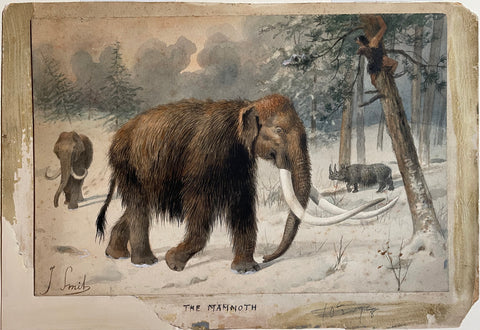
Joseph Smit (1836-1929), The Mammoth
Joseph Smit (1836-1929)
The Mammoth
Original Illustration in pen, ink and grey wash, heightened in white.
c. 1905-1912.
7 1/4 x 10 5/8 in. sheet
Original artwork for Henry R. Knipe’s Nebula to Man. Illustrated on page 195: “The Mammoth”.
Mammoths stem from an ancestral species called M. africanavus, the African mammoth. These mammoths lived in northern Africa and disappeared about 3 or 4 million years ago. Descendants of these mammoths, M. meridionalis, moved north and eventually covered most of Eurasia. Around 1.8 million years ago, M. meridionalis took advantage of low sea levels (during an Ice Age) and crossed into North America via a temporary land bridge across the Bering Strait. Later, in the Middle Pleistocene, a new North American species evolved, M. imperator. Again, in the Late Pleistocene, the Columbian mammoth, M. columbi (also known as the Jefferson mammoth, M. jeffersoni), evolved. Its range covered the present United States and as far south as Nicaragua and Honduras.
Back in Eurasia, another species of mammoth, the steppe mammoth (M. trogontherii), lived from 200,000 to 135,000 years ago. Later, during thhe Pleistocene, the smallest of the mammoths evolved, the woolly mammoth (M. primigenius). During another Ice Age around 35,000 to 18,000 years ago, woolly mammoths entered North America via a new land corridor across the Bering Strait. Woolly mammoths’ migration extended south to present-day Kansas.
New research published in the journal Nature in February this year unearths a novel, unknown lineage of mammoths linking the two previously known species, the Columbian mammothh and its popular cousin, the wooly mammoth. A team of researchers lead by Dr. Dalen and Dr. Díez-del-Molino came to this brilliant discovery upon extracting a million-year-old DNA--the oldest DNA ever taken from a fossil-- from three mammoth molars found in Northern Siberia.
There is hope for a resurgence of this once-extinct mammal, as The Woolly Mammoth Revival Project lead by George Church of Harvard University hopes to use genomic biotechnology to repopulate the Arctic with a wooly mammoth “proxy” species. According to the Church Lab’s mission statement, “the ultimate goal of Woolly Mammoth Revival is to bring back this extinct species so that healthy herds may one-day re-populate vast tracts of tundra and boreal forest in Eurasia and North America. The intent is not to make perfect copies of extinct Woolly Mammoths, but to focus on the mammoth adaptations needed for Asian elephants to thrive in the cold climate of the Arctic.”
JOSEPH SMIT (1836-1929)
Josef Smit’s dinosaur drawings are a high point in his fine draughtsmanship and unique in his vision to construct an image based on a written description rather than a physical specimen. Knipe’s preface indicates that Smit also learned much from Charles Knight’s drawings at the Museum of Natural History, New York.
Josef Smit was born and raised in Lisse, in southern Holland. Later, in Leiden, his scientific fidelity came to the Natural History Museum of Leiden director Hermann Schlegel’s attention. He presented the artist with his first commission to paint a series of birds from the Dutch East Indies. Smit’s work for Schlegel earned him a significant commission to prepare hundreds of plates for Philip Sclater’s Exotic Ornithology. Once in London, the artist met other like-minded artist-naturalists and developed a reputation for preparing very realistic drawings. Because of his ability to delineate every detail of a specific bird, he was employed by several scientists to illustrate their reports and publications. His work stood apart from his contemporaries in his addition of thorough backgrounds of leaves, vines, and tree branches. Smit eventually became a key contributor to some of the most important natural history publications of the 19th and early-20th centuries. His work graced the tomes by John Gould, Edward Lear, Archibald Thorburn, Henry Constantine Richter, and J.G. Keulemans. His son, Pierre-Jacques Smit was also a skilled watercolorist.
ORIGINAL WATERCOLORS PREPARED FOR HENRY KNIPE’S
NEBULA TO MAN (1905) & EVOLUTION IN THE PAST (1911-1912)
An exceedingly rare collection of original watercolors prepared for Henry Knipe’s Nebula to Man (1905) and Evolution in the Past (1911-1912) by naturalist-artists Alice Woodward, Josef Smit, and Charles Whymper.
Drawings prepared for Knipe’s Nebula to Man (1905) contributed to one of the most important publications on dinosaurs on the heels of the Great Dinosaur Rush or Bone Wars. The Bone Wars occurred between 1877 and 1892 between Edward Drinker Cope, the Academy of Natural Sciences Philadelphia, and Othniel Charles Marsh, the Peabody Museum of Natural History at Yale. These early paleontologists fought ruthlessly to pursue dinosaur fossils, a quest that resulted in an extraordinary period of discovery and the eventual financial ruin of both scientists. Their findings resulted in unearthing 136 new dinosaur species, ushering in a new paleontological research era.
According to Henry Knipe’s obituary, he worked for the British Museum. It was there that he likely met the artists tapped for this project. Knipe chose each illustrator for their reputation for scientific authenticity—namely, those skilled as bird artists, given the many similarities between bird species and dinosaurs.
We Also Recommend

![Albertus Seba (1665-1736) Tab I [Insects]](http://aradergalleries.com/cdn/shop/products/I_large.jpg?v=1635434052)
![Albertus Seba (1665-1736) Tab II [Insects]](http://aradergalleries.com/cdn/shop/products/II_large.jpg?v=1635434726)
![Albertus Seba (1665-1736) Tab III [Insects]](http://aradergalleries.com/cdn/shop/products/III_large.jpg?v=1635434877)
![Albertus Seba (1665-1736) Tab L [Insects]](http://aradergalleries.com/cdn/shop/products/L_b_large.jpg?v=1635435506)
![Albertus Seba (1665-1736) Tab L [Insects]](http://aradergalleries.com/cdn/shop/products/L_large.jpg?v=1635437893)